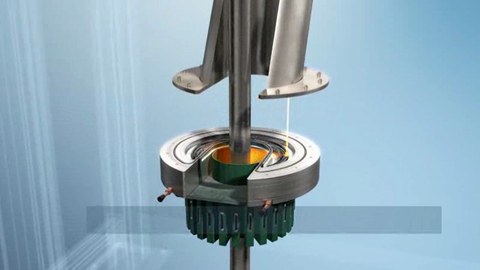Jan 13, 2023
Nuclear safety research: 1.3 million euros awarded to junior research group from TU Dresden and Helmholz-Zentrum Dresden-Rossendorf (HZDR)

ROFEX, the ultrafast electron beam X-ray computed tomography system at the Helmholtz-Zentrum Dresden-Rossendorf (HZDR), can record up to 5,000 images per second – a world record. It enables the visualization of flows as they occur in the primary coolant circuit of nuclear power plants and thus contributes to nuclear safety research.
As a consequence of Germany’s phasing out of nuclear power, young people are steadily losing interest in the subject area of nuclear safety research. The number of graduates in this area is declining and there are ever fewer nuclear experts in Germany. At the same time, Germany still needs these specialists simply by virtue of the fact that our neighboring countries continue to operate existing nuclear power plants and build new ones. Moreover, new types of reactor such as smaller modular or liquid metal-cooled ones are also being developed. These require specialized safety research and expert knowledge. Another technological and infrastructural challenge is the disposal of highly radioactive waste – an issue that will likely affect Germany for decades to come. The junior research group RIMANUS at TU Dresden seeks to counteract the impending loss of expertise and establish appealing educational research programs to recruit young early-career researchers for nuclear safety research.
The RIMANUS project has prevailed as part of an initiative of the Federal Ministry for the Environment, Nature Conservation, Nuclear Safety and Consumer Protection for promoting groups of early-career researchers in nuclear safety research at German universities. Over the next three years, the junior research group will receive 1.28 million euros in funding. Their research activities will focus on the refinement and use of innovative imaging processes for current issues in reactor safety research as well as the monitoring of nuclear fuels.
Today’s nuclear reactors are primarily light-water reactors. For safe operation, cooling the reactor core is an imperative process in the event of a malfunction. However, if for instance the pressure system has a leak, water will evaporate and the emergency core cooling system will be impaired. A well-known malfunction was the reactor accident in Fukushima, where a power outage led to cooling failure and in turn a core meltdown.
“Current research focuses on predicting when the cooling system would no longer suffice in cases of reactor failure. Therefore, we – and other research groups around the world – are working on both creating computer simulations and conducting experiments. Such experiments require appropriate measurement technology to analyze flow behavior. Image-generating measurement methods such as those developed at HZDR can contribute immensely,” explains Dr. Michael Wagner, RIMANUS Project Leader.
Ultrafast electron beam X-ray computed tomography at the Helmholtz-Zentrum Dresden-Rossendorf has enabled scientists to make liquid-gas flows in pipelines visible to the human eye at up to 5,000 frames per second. This unique imaging technique was primarily developed at the Helmholtz-Zentrum Dresden-Rossendorf and is being used and adapted for various applications at the Chair of Imaging Techniques in Energy and Process Engineering at TU Dresden. “Our objective for the RIMANUS project is to take these X-ray imaging techniques a step further to generate 3D images and create greater beam energy for nuclear safety research,” says Wagner.
The junior research group is also looking into how to store spent nuclear fuel. Since there is currently no final repository in Germany, radioactive waste has to be temporarily kept in storage and transport containers – most commonly CASTOR casks – for well over 50 years. Researchers do not currently have the appropriate knowledge to ensure that the spent fuels will remain intact and unchanged over the course of these long storage periods. However, this information is imperative for later transferring the material to final storage vessels. It would be preferable to be able to apply a non-invasive test method that would allow scientists to gain knowledge about the state of the fuel behind the 50-centimeter thick steel walls of storage containers and avoid opening them prematurely. One possible option is the use of cosmic-ray muons. Using these simply charged particles, which are created in the Earth’s upper atmosphere and are capable of penetrating even very large, thick objects, RIMANUS researchers want to implement muon imaging to inspect the temporary storage containers for spent nuclear fuel.
The RIMANUS (“Innovative Radiation-based Imaging Techniques for Nuclear Safety Research”) research group is headquartered at TU Dresden’s Chair of Imaging Techniques in Energy and Process Engineering. Practical research is conducted at the Helmholtz-Zentrum Dresden-Rossendorf.
Media inquiries:
Dr. Michael Wagner
TU Dresden
Faculty of Mechanical Science and Engineering
Chair of Imaging Techniques in Energy and Process Engineering at TU Dresden
Tel.: +49 351 260-2334
